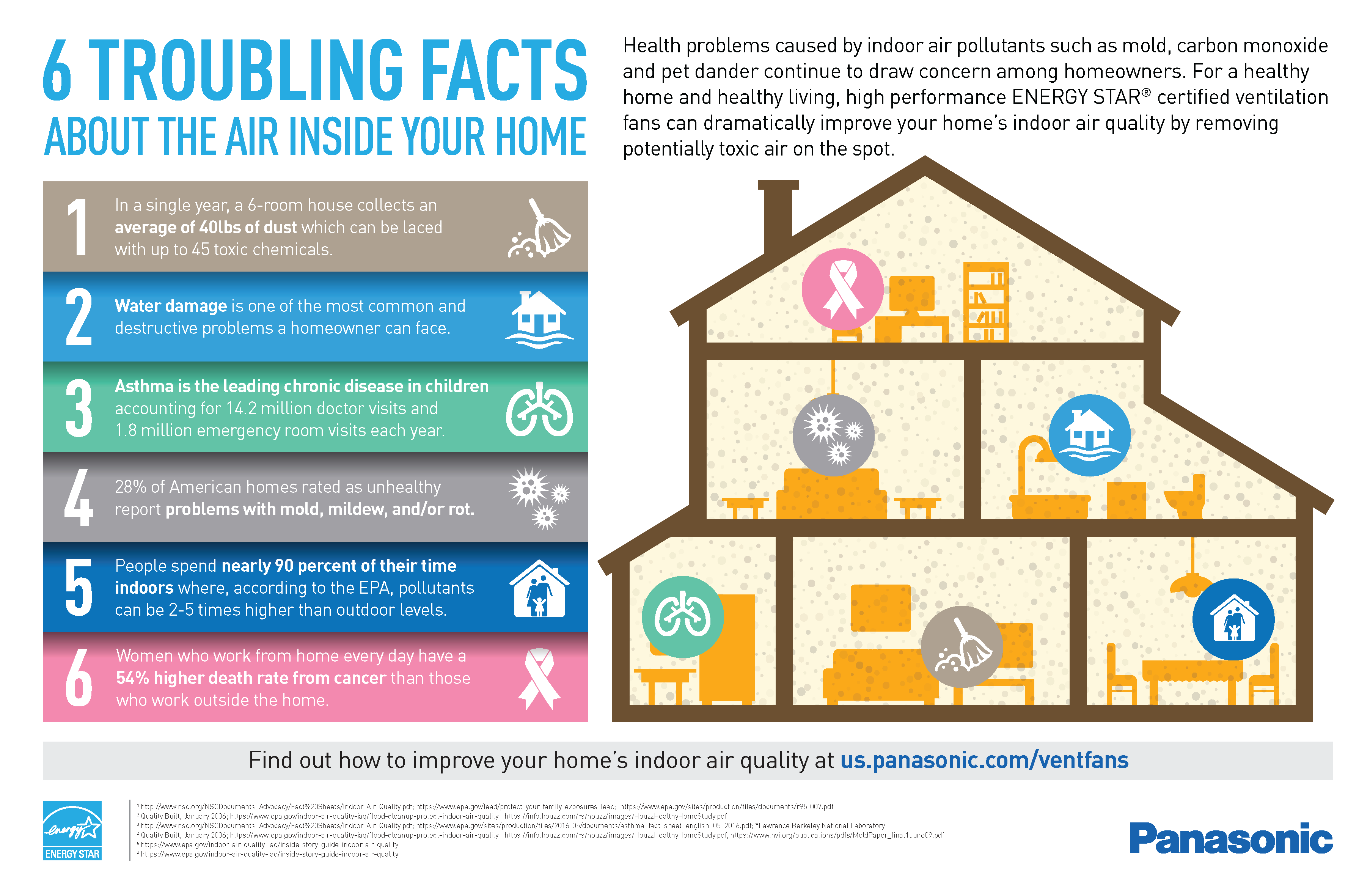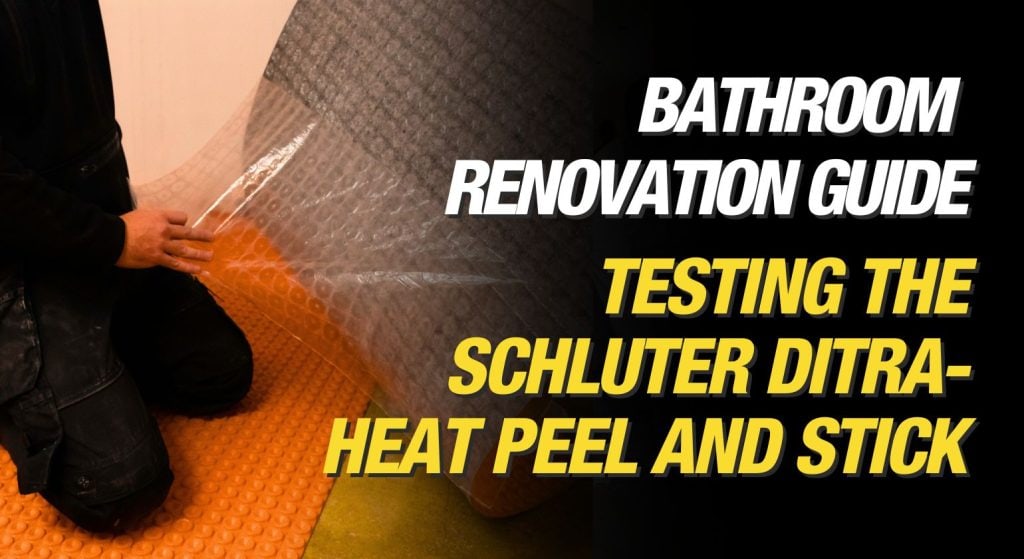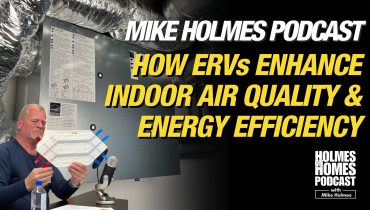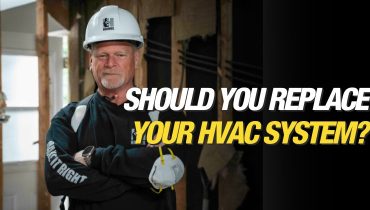When it’s time to replace your HVAC system, you have several options, each with its own benefits. Choosing the right HVAC system depends on your home’s size, climate, energy needs,...
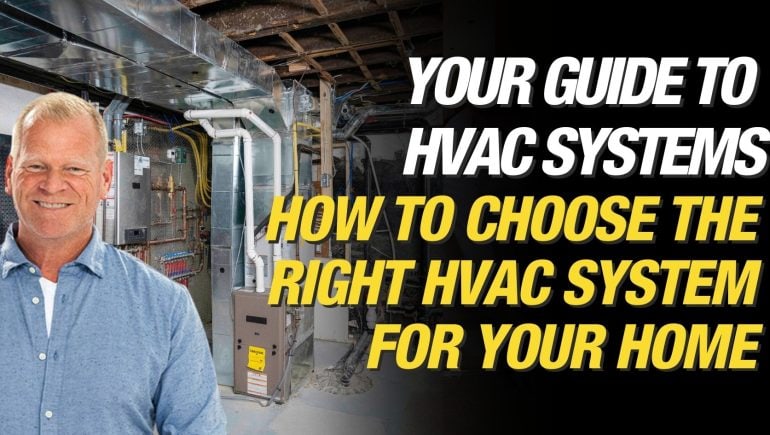
How To Choose An HVAC System For Your Home
By Mike Holmes
Mike’s Advice / Home Renovation
Wednesday, April 19th, 2023 @ 3:02pm
Which HVAC System is Right for Your Home?
You might be surprised to know that some people don’t actually know what HVAC means. They don’t understand what HVAC systems they have in their homes, even though this is the heart of your home. So what should you be looking for when choosing an HVAC system if you’re in the market for a new one?

Mini-Split Heat Pump System Installed In Sunroom in Frank Cozzolino’s Home, in Holmes Family Rescue
Here is my full guide on HVAC systems and how to choose the right system for your home.
What Does HVAC Stand For?
For starters, what does HVAC mean? HVAC literally stands for HEATING, VENTILATION, AIR CONDITIONING – all the systems that when combined create comfortable living conditions for your home. HVAC systems control and distribute warm and cool air and are often one of the most complicated systems in your home.
What Are The Different Components Of An HVAC System?
To understand how HVAC systems work, it’s essential to know their various components. Here’s a breakdown of the main parts of an HVAC system and how they work together to regulate your home’s temperature.
Furnace
Did you know that the word furnace originates from the Greek word for oven, “fornax? Air is heated by a furnace and this warm air circulates throughout a home using ducts. However, it’s a bit more complex than that. A complete HVAC system contains air returns, filters, exhaust outlets, ducts, electrical elements, an outdoor unit, a compressor, coils and a blower.
Air Conditioner
An air conditioner eliminates heat and humidity from the indoor air and creates cool air within your home.
Heat Pump
A residential heat pump is an HVAC system that uses refrigeration and electricity to provide heating and cooling to a home. A heat pump has the ability to deliver heating and cooling with a higher level of efficiency, compared to furnaces, boilers and electric baseboard heating. This is because heat pumps move heat rather than generate heat.
In fact, a heat pump can reduce your electricity consumption by 50% compared to electric resistance heating such as furnaces or baseboard heaters (according to the US Department of Energy). Depending on where you live and a lot of other factors, heat pumps can make a great alternative to your Air Conditioner and even furnace —with all your heating and cooling needs packed into one unit.
PRO TIP:
Looking to really maximize your energy usage and home comfort? Go with an inverter heat pump. With inverter systems, you don’t have to deal with the uncomfortable temperature jumps that are caused by frequent on and off cycles. Inverter heat pumps are able to self-adjust in order to keep the temperature in the room nice and steady. I recommend checking out Bosch’s IDS systems, they are high quality and super efficient.
RELATED:
Boiler
The majority of the country’s main heating systems, which are often fueled by fossil fuels like natural gas, are forced-air furnaces and hot water or steam boilers with radiators. Electric boilers are considered to be a more environmentally friendly option than gas- and oil-fired boilers because they don’t emit CO2 —reducing your home’s carbon footprint.
A boiler boils water that will heat your home, and the heat is in the form of hot water or steam. You can also heat water with a boiler. A typical heat-only boiler has a separate requires a separate indirect hot water storage tank for larger homes that have 3 or more bathtubs. On the other hand, combi boilers produce heat and hot water through a single unit.
RELATED:
Ductless System
A ductless mini-split system consists of one outdoor unit and one indoor unit connected by electrical cable and refrigerant tubing. Without the use of ductwork, the indoor unit, which is frequently wall-mounted, forces heated or cooled air into the living area.
You have more control over how much energy is spent cooling each room because ductless systems have the ability to zone, meaning you can manage what rooms are controlled by the ductless system.
Because there is no ductwork, ductless mini-splits can be great, hassle-free options for new construction (such as adding a home office or garage) as well as retrofits. Bosch mini-splits are easy to install and maintain —can’t beat that.
Thermostat
A thermostat is nothing more than a set of controls used to manage and maintain the chosen temperature in the room that you have set. Many of the smart thermostats on the market let you control your home’s heating, cooling, and ventilation completely from a distance; some even display your energy use in real-time. How clever is that? Some of the newest smart thermostats may even utilize geo-fencing technology to reduce the temperature when you leave the house in order to save energy.

A smart thermostat can help save you money on your monthly bills.
Types of HVAC Systems
Single or Multi-Stage
When it comes to choosing an HVAC system for your home, you’ll need to decide between single-stage and multi-stage systems. Single-stage HVAC systems typically include an air conditioner and a heater (such as a furnace or boiler). On the other hand, multi-stage systems have more than one source of heated or cooled air. As an example, a multi-stage heating system could include both a furnace and a heat pump to provide heat. These systems require a multi-stage thermostat, as multiple inputs must be managed simultaneously.
While single-stage systems are generally less expensive, multi-stage systems can provide more precise temperature control and may be more energy-efficient in the long run. Ultimately, the right choice depends on your specific needs and budget.
Zoned Systems
An HVAC zoning system divides your home into multiple zones, each controlled by its own unit or thermostat. The benefit of that is that it allows you to set each room to the ideal temperature instead of heating or cooling the entire home to just one temperature.
A zoned HVAC system can give you more control over your comfort, provide energy savings and, most importantly, eliminate daily arguments over the thermostat!
RELATED:
The Air Conditioner Equipment of A HVAC System
In warmer climates, air conditioning is a crucial component of HVAC systems. From the compressor to the evaporator coil, here are the essential parts of an air conditioning unit and their roles in maintaining a comfortable indoor temperature.
Fan of HVAC System
A fan is an essential part of every HVAC system. The three types of HVAC fans most frequently used are axial, centrifugal with a forward bend, and backward inclined. Each of these fans has its own unique applications and the right type will depend on the specific needs of your HVAC system. Most HVAC systems in homes use forward-curve fans, also known as “squirrel cage” fans, even though they resemble hamster wheels a bit more. They are noisier and use more energy than axial fans because they can produce more air pressure. They have fewer issues with resistance, are long-lasting, and are simple to clean and maintain.
Centrifugal fans with a forward curve, also known as blowers, are used to circulate air via ductwork in your house. Most HVAC systems in homes use forward-curve fans. Although they are noisier and use more energy than axial fans, they are more commonly used due to their versatility and ability to move air at high pressures. They also have fewer issues with resistance, are long-lasting, and are simple to clean and maintain.
Backward-inclined fans are excellent for high volumes of airflow and variable resistance. They are also quieter than forward-curved fans. However, they are often used for more commercial purposes.
Axial fans look like propellers and suck air directly into the fan. Large chillers and condensing units frequently use axial fans. For ease of installation into HVAC equipment and to reduce vibration, these fans and blowers are frequently mounted to an outside frame.
Compressor of HVAC System
An evaporator, condenser, and compressor comprise the central air conditioning system. The cooling cycle of an HVAC system depends heavily on the compressor. The compressor acts as a middleman between the condenser, the unit outside your home, and the evaporator housed inside your air conditioner.
Its function is to pressurize and circulate the refrigerant to ensure it can gather heat from the indoor air and release it outside. There are many different types of compressors, including reciprocating, rotary, and scroll ones. They can be powered by combustion or electricity.
The effectiveness of the cooling system as a whole depends on the compressor’s efficiency and dependability. For the HVAC system to work at its best, use the least amount of energy, and last as long as possible, proper maintenance and compressor sizing are necessary.
Condenser Coil
The condenser coil is one of two coils in your air conditioning or heat pump system that removes heat from the refrigerant. Once the refrigerant is pressurized and heated in the compressor, it enters the condenser coil.
Refrigerant Filled Tubing
Refrigerant lines are insulated copper lines that transport refrigerant between your outdoor and indoor ac or heat pump units. It’s made up of two lines, one line transporting gaseous refrigerant while the other carries liquid coolant.
Gas Forced Air Furnace Equipment
Gas-forced air furnaces are a common heating system found in many homes, especially in areas with cold climates. Understanding the different components of a furnace and how they work together can help you better understand what you should be looking for when choosing an HVAC system.
Heat Exchanger
The heat exchanger is in charge of moving heat from the combustion process to the air being circulated in your home. The heat exchanger collects heat from the flames produced by the burners. It then transmits it to the circulating air, which is ultimately moved throughout the house.
It is crucial that the heat exchanger is working correctly since a leak or crack could pose a threat to your safety, as it can cause dangerous quantities of carbon monoxide to be released. Regular inspections and cleaning can assist ensure that the heat exchanger is operating safely and effectively. It’s critical to act quickly if you believe your heat exchanger may be having issues.
Blower
The HVAC blower motor is a part of the home’s heating and cooling system that transports heated, cooled, or otherwise conditioned air from the furnace, heat pump, or air conditioner. The blower motor propels heated or cooled air through the ductwork and out of vents around the house.
Filter
The air filter captures airborne particles like dust, pollen, and pet dander to help maintain indoor air quality by enhancing the air you breathe. It also protects the furnace’s blower motor and other parts from damage. The effectiveness of the furnace can be decreased over time and even damaged if the air filter becomes clogged and restricts airflow. Depending on usage and the kind of filter, the air filter should be checked and replaced regularly. I usually recommend once every one to three months.
Return Air Duct
The component of your system that signals the beginning of the ventilation cycle is your air return. This return pulls air in, filters it, and then sends it into the primary system. A pro suggestion is to regularly dust your returns because dust and debris can readily collect on your filters. A good rule of thumb is to switch out your air filter at least every 3 months.
Ductwork
The air handler is connected to the ductwork’s duct pipes and trunks, which enable heated or cooled air to be distributed throughout your house. The duct trunk is your home’s main truck, and the duct pipes that link to it provide each room with air.
The air for the HVAC system is kept in a large box called a plenum, which is joined to all of the ducts. Your HVAC system’s ductwork typically has two plenums: a supply plenum and a return plenum. The warm or cooled air from the HVAC system will fill the supply plenum before being routed via the ductwork.
The air that is already present is forced out of the room and into another set of ducts when this heated or cooled air enters the area. The returning air is transported by these ducts to the return plenum. Depending on your HVAC system, the returned air is either transported through the heating and cooling cycle once again or is sent outdoors through a chimney.
Humidity Control
Most modern HVAC systems are capable of regulating humidity. Your HVAC system has an evaporator coil that condenses water vapour from the air, similar to when condensation appears on the outside of a glass containing a cold beverage. The moisture is collected in the drain pan and is sent outside your house through a drain pipe. This process results in the dehumidification of your room.
With that said many newer homes are built to be airtight. This is a good thing for your home’s energy efficiency. However, there needs to be a way to expel that pent-up, moisture-filled stale air and replace it with fresh outdoor air. Also, managing the humidity levels in your home can improve your indoor air quality. Installing a heat recovery ventilator, or even better, an energy recovery ventilator (ERV), is my number one recommendation for correctly producing an effective air exchange.
What Is An ERV?
Managing humidity levels is essential to improving indoor air quality, which is why ventilation fans in kitchens and bathrooms are so important. An ERV system is an excellent solution for improving indoor air quality.
Energy Recovery Ventilators are excellent at controlling the humidity in the air brought into your home. The ERV transmits humidity from the extracted air throughout the winter, guaranteeing consistent humidity levels. In the hot summer months, on the other hand, the ERV eliminates moisture from entering the air, reducing the strain on your air conditioner and dehumidifier. With an ERV installed, you may enjoy a continuous exchange of fresh air, resulting in a comfortable and refreshing indoor environment.
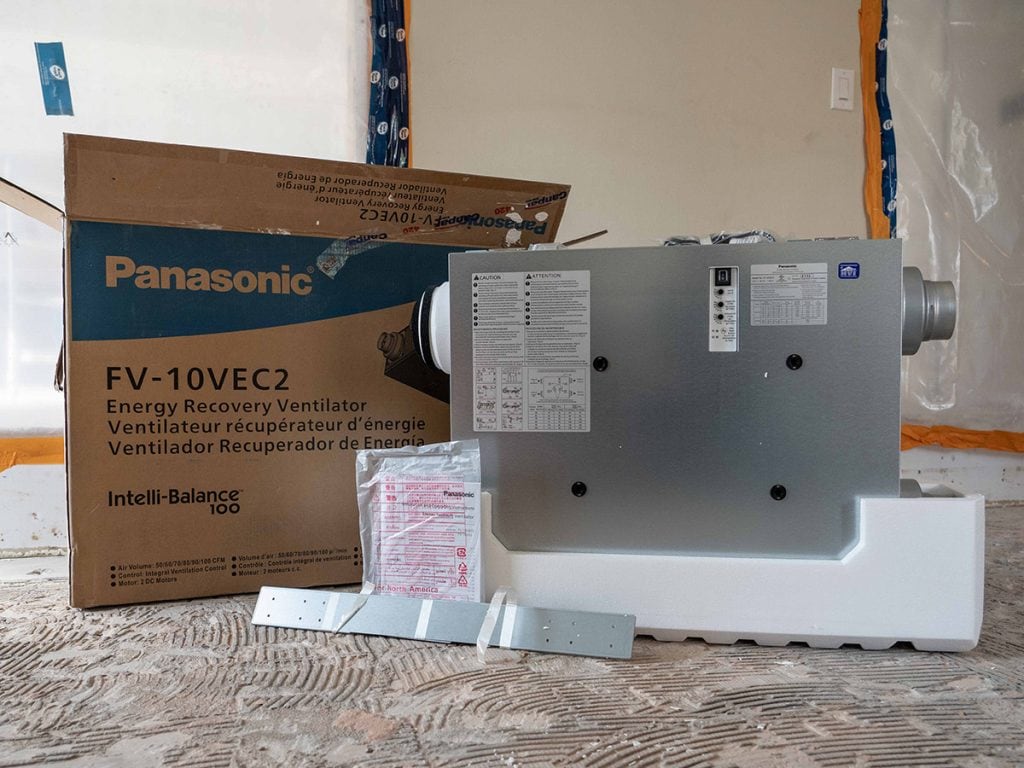
Panasonic Intelli-Balance 100 ERV installed at my house.
I recently had the opportunity to install the Panasonic Intelli-Balance 100 energy recovery ventilator in my crawl space during my home renovation work. This system is particularly built for new, energy-efficient homes, exceeding every standard needed and receiving Energy Star certification.
Here are some of its key features:
- The core material is permeated with anti-mould treatment to help prevent mould
- Connect to existing ductwork or use as a standalone, whole-house ventilation solution
- Built-in controls minimize the time it takes to determine the desired airflow, as well as verify and maintain performance. Love this.
- Does not require connection to the Central HVAC or the addition of a condensation line.
- Two (2) ECM brushless motors with built-in SmartFlow™ technology for precision ventilation. When the ERV senses static pressure, its speed is automatically increased to ensure optimal CFM output; regardless of a complicated duct run.
- A hinged access panel makes it quick and easy to do maintenance and filter checks.
RELATED:
House Too Humid? Here Is What To Do
How to Choose the Right HVAC System for Your Home
Selecting the right HVAC system for your home requires a complex design that must balance many factors including:
- Heating and cooling needs;
- Energy efficiency;
- Humidity control;
- Potential for natural ventilation;
- Adherence to codes and standards;
- Outdoor air quantity and quality;
- Indoor Air Quality (IAQ); and
- Cost
So how do you choose the right HVAC system?
Location – Where Do You Live (Region and Climate)
Let’s take an example help make things easier. What type of HVAC system would be good for a 1000 sq ft home in Toronto?
For starters, Toronto temperatures can get downright chilly, below -20C and summers can be as hot as 35C. A ductless mini-split system or a small central air conditioning system with a gas furnace may be suitable for a home of this size.
A heat pump may not be the most efficient option for this climate. However, if you are considering a heat pump as a supplement to your system, you would need to choose a model with a high heating capacity that can operate efficiently in cold temperatures.
The Heating Seasonal Performance Factor (HSPF), which measures a heat pump’s heating efficiency, should be at least 8. Ideally 10 or greater. Your required heat pump’s size or capacity will vary depending on your home’s size, insulation level, and environment.
A 1-ton heat pump can normally heat and cool 400–600 square feet of living space, as a general rule. As a result, you might require a heat pump with a capacity of 1.5 to 2.5 tonnes for your 1000-square-foot home.
However, this is only a rough estimate and the actual size or capacity of the heat pump may vary, and you may need additional systems to provide you with sufficient heat for your home – always consult with a professional HVAC technician to assess your home to provide the right recommendations for your home.
Home Size and Construction
The type of construction and the size of your home can have a significant impact on your HVAC system. The heating and cooling load is determined by the size of your home, insulation, window type and orientation of your home all need to be considered. That’s why you need to consult with an HVAC pro!
A larger home with inadequate insulation, inefficient windows (single pane or older windows with seal issues), and a drafty building envelope will require a bigger HVAC system to handle the home’s HVAC needs, not to mention the higher energy bills.
To maintain optimal indoor air quality, a home’s ventilation system is crucial. Multiple ventilation systems, such as fresh air intakes (ERVs and HRVs) and exhaust fans (in kitchens and bathrooms), are good additions to your HVAC system.
Retrofit Options
There are many older homes in Canada, and there will always be new products and technology introduced. Retrofitting an existing HVAC system is the process of integrating new components into an older system. If it sounds complicated, that’s because it is! That’s why it’s important to do your research, get an energy audit and discuss all your options with an HVAC specialist.

Bosch Heat Pump Outdoor Unit Installed on one of our latest projects for Holmes Family Rescue.
Efficient- Energy Energy Star Rating
The Energy Star label is to help homeowners make informed decisions. HVAC systems with the ENERGY STAR label adhere to rigid energy efficiency requirements. The U.S. Environmental Protection Agency (EPA) and the standards development team worked together to promote considerable reductions in dangerous greenhouse emissions.
Products with the ENERGY STAR rating are also easier on your wallet when it comes to your home’s energy costs. The ANNUAL FUEL UTILIZATION EFFICIENCY (AFUE), the SEASONAL ENERGY EFFICIENCY RATIO (SEER), and the HEATING SEASONAL are all combined to determine an energy rating.
Ductwork
Your HVAC system’s ductwork, which connects your furnace and air conditioner to the vents, is an essential component of your system. The size of ductwork is determined by the size of each room and the overall house. The efficiency of the HVAC system can be impacted by the size and layout of the ducting.
More ductwork and longer runs will be needed for larger dwellings. However, keep in mind this could result in higher resistance and air pressure losses, lowering system efficiency.
If you live in a smaller house you may want to consider a ductless system. We installed the Climate 5000 Ductless System by Bosch on a number of our projects. It doesn’t require any ductwork and is very quiet, I love that!

Climate 5000 Ductless System. Super quiet with sound levels as low as 20 dBA.
Scheduling HVAC Maintenance
No matter what kind of HVAC system you have, it should be properly maintained. That includes an inspection and cleaning at least once a year by a professional technician.
However, I think it’s best to do an inspection twice a year, once in the early fall and once in the early spring. By doing this your HVAC system will never let you down.
But keep in mind, that some things need replacing or cleaning more often. This can include filters in your HVAC, and possibly your HRV or ERV.
Heating and Cooling Terms
What Does Annual Fuel Utilization Efficiency Rating (AFUE) Mean?
The annual fuel utilization efficiency (AFUE) rating measures the efficiency of furnaces. This is a seasonal measure of fuel efficiency only. It does not include the electrical energy required to operate controls, fans or pumps. The higher the AFUE rating, the more efficient the unit is, according to the EnerGuide of Canada.
What Does Seasonal Energy Efficiency Rating (SEER) Mean?
SEER stands for Seasonal Energy Efficiency Rating. SEER2 is an updated version of SEER for air conditioners and heat pumps, effective Jan. 1, 2023. This is the ratio of the cooling output of an air conditioner and heat pump over a typical cooling season, divided by the energy it uses in Watt-Hours.
What Does HSPF2 Mean?
HSPF stands for Heating Seasonal Performance Factor. It measures the efficiency of a heat pump over the fall and winter seasons. HSPF2 is an updated version of HSPF set by the Department of Energy (DOE).
What Do Radiant Floors Mean?
Radiant systems heat the floor. That heat then radiates up and is absorbed by other objects in the room, warming the entire space efficiently. In short, heated floors use radiant heat technology to make the floors warm. The heat from the floors then rises and disperses throughout the room.
There are two types of radiant floor heating: hydronic and electric. We always install Schluter Ditra-Heat electric in-floor warming systems in all our projects and it’s great.

We install Schluter Ditra-Heat in-floor warming systems on all our projects.
RELATED:
When considering a new HVAC system, consider how different heating and cooling systems will affect the temperature, energy use and air quality in your home. Pay attention to the system ratings and capacity identified by BTUs (British Thermal Units). Typically, the capacity increases as the BTUs get bigger. Any newly manufactured HVAC system comes equipped with a programmable or smart thermostat, which is practical and promotes energy efficiency.
All HVAC systems require routine maintenance for optimal performance. Consider investing in a low-maintenance, economical system for your peace of mind. Remember, take into account cost and noise levels too. HVAC systems are complicated. Make sure to do your research and speak to several experts before deciding on the right HVAC system for you!

A home protection plan is a smart investment to protect the major systems of your house, such as heating and cooling, appliances etc. Check out the Mike Holmes Protection Plan packages!
READ NEXT:
13 Best Home Products from 2022



